 This review is part of the Cameras of the Dead series which I have been publishing every year on Halloween and “Halfway to” Halloween, featuring three cameras that I’ve wanted to review that either didn’t work, or was otherwise unable to shoot.
This review is part of the Cameras of the Dead series which I have been publishing every year on Halloween and “Halfway to” Halloween, featuring three cameras that I’ve wanted to review that either didn’t work, or was otherwise unable to shoot.
I am republishing each of those individual reviews this October in anticipation of this Halloween’s Cameras of the Dead post as a way to revisit the cameras of the past that allows them to be properly indexed on the site.
This is a Kodak Signet 80 rangefinder camera made by the Eastman Kodak company out of Rochester, NY in 1958. It was the most advanced, and also the last of the Signet line of cameras. It was the only Signet model to have an interchangeable lens mount and represented one last attempt by Kodak to make a mainstream “system” camera. A combination of high prices and low specs doomed the camera from the beginning and it did not sell well. The Signet 80 was one of Kodak’s last attempts at building anything resembling an advanced camera as all new models released after this camera were cheap point and shoot Instamatic models. Despite it’s lackluster history, this is a solidly built camera with a couple of compelling features, and like most of the Signet line, came equipped with very capable lenses.
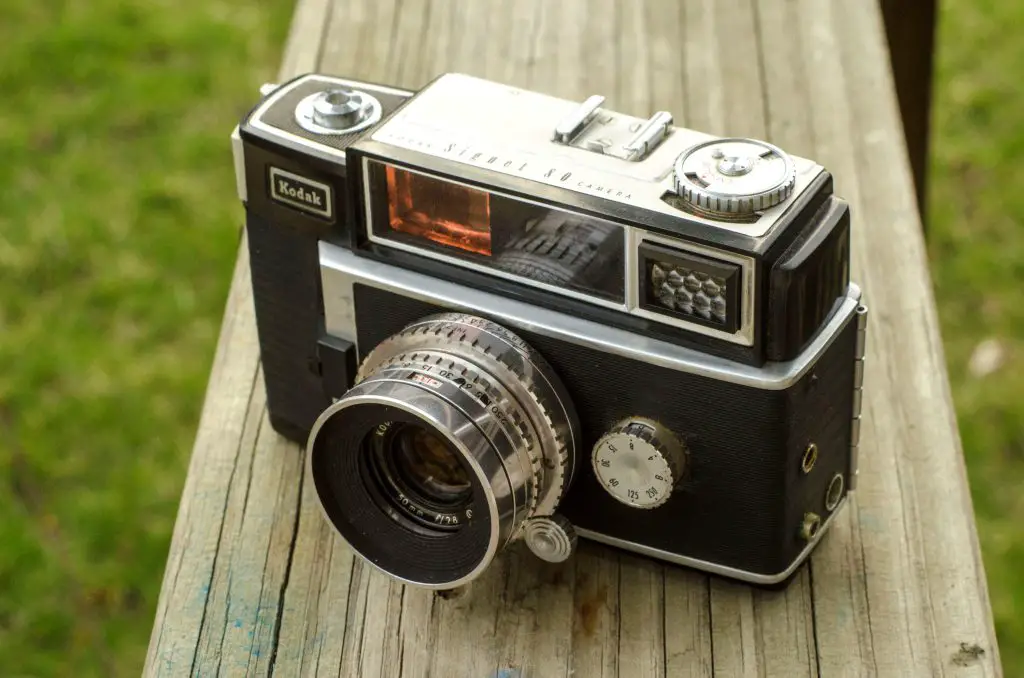 Film Type: 135 (35mm)
Film Type: 135 (35mm)
Lenses: Kodak Ektanar 50mm f/2.8 and Signet Wide Angle 35mm f/3.5 coated 4 elements
Lens Mount: Scissors Lock Signet 80 Mount
Focus: 2.5 feet to Infinity
Type: Combined Coincident Coupled Rangefinder
Shutter: Leaf
Speeds: B, 1/4 – 1/250 seconds
Exposure Meter: Selenium Cell
Battery: None
Flash Mount: Cold Shoe, PC M & X Socket, Kodak proprietary flash mount
Manual: http://www.cameramanuals.org/kodak_pdf/kodak_signet_80.pdf
My Thoughts
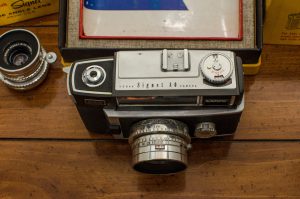
There was once a time when I fell victim to the popular theory that the only good Kodak cameras were ones with the name “Retina” on them. Then I discovered the Kodak Medalist. A honking beast of a solid piece of metal with one of the most amazing 5 element Ektar lenses on it. Next came a little afterthought of a camera that I paid $5 for, called the Kodak 35 with the Anastigmat Special lens. This little 1930s Bakelite gem has turned out to be one of my favorite vintage cameras of the 80+ in my collection. After that came the mostly aluminum Kodak Signet 35. It was the first in a whole series of Signet cameras, and was an extremely handsome camera in a mostly aluminum body with an awesome 4 element Ektar lens.
I was getting cocky. Upon learning of a more advanced Signet model that had interchangeable lenses, and a similarly good Ektanar lens, I knew I had to have one. Ironically, the one pictured here is the second one I tried to buy. The first was one I won on eBay and paid for, but the seller never shipped it. A claim to eBay and 30 days later, I got my money back, no worse for the wear, so I set my sights on another. My fortunes turned good as I found a very clean looking example in it’s original box, with a nice field case, and the Signet wide angle auxiliary lens. Score! Two lenses for the price of one!
My excitement turned to dismay as I received the camera as it was in pretty terrible shape. For one, the auxiliary lens was completely seized and I could see one of the iris blades was dislodged. The 50mm lens was OK, but very stiff. The viewfinder was large and bright, but the rangefinder had severe vertical alignment problems. Usually a small amount of vertical error won’t negatively affect your focus, but this was way off. Finally, the deal breaker was that I could cock the shutter, but nada. It was seized.

Thinking I had another job for my trusty bottle of Ronsonol lighter fluid, I soaked this thing, repeatedly, but no amount of lubrication would get the shutter to budge. I came to the conclusion that something was physically damaged inside of the camera. The first time I removed the lens, I could see a metal plate that encircles the shutter was loosely flopping around inside of the body. I thought perhaps I could open the body, but the solid Bakelite plastic did not reveal how to get itself open. I searched online for CLA instructions on this camera and found none.
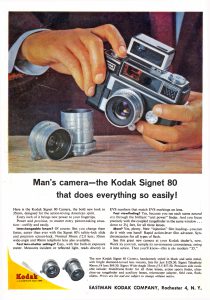
The Signet 80 did not sell well. While it should have been a pretty desirable model for Kodak, the very limited selection of shutter speeds, coupled with it’s ‘love it or hate it’ styling, and it’s $130 price tag in 1958 (when adjusted for inflation, that’s $1082 today) meant that very few were sold. I found stories that around the time of it’s discontinuation, camera shops had these things on clearance on the shelf trying to sell them at bargain prices and still had a hard time moving them.
So, with so few sold, and it’s rather poor reputation, it’s no surprise that finding repair information on them today is difficult. I quickly realized that I was over my head, and knowing that I had at least a cosmetically good looking specimen with it’s original box, field case, and an extra lens, I listed it on eBay and broke even.
Would I take a chance on another Signet 80? I honestly don’t know. I can say that if you like quirky cameras, this one has quite a few for you. For starters, the shutter speed selector is on a dial on the front of the camera, kind of like an Argus C3. I can forgive this odd location on the Argus considering that camera was designed in 1938. This one came out 2 decades later and Kodak should have known better. Second, the frame counter was strangely on the bottom plate of the camera, just beneath the lens. It’s a very strange location and one that’s not even obvious the first time you look at it. I would not be surprised if at least a few people used this camera without ever realizing there is a frame counter on it.
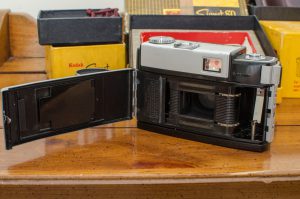
Finally, the strangest design element of the camera is something Kodak actually advertised as a good thing. The film compartment had no take up spool. Instead it had a hollow chamber that allowed the exposed film to coil around itself in as you advanced the film. Kodak referred to this as “injection” loading. The idea was that by not needing a take up spool, the loading process was greatly simplified. You would simply install a new cassette on the supply side, and then feed the film leader into a slit that opened into the hollow chamber, and then close the door. As you advanced the film, two gears would pull the film out of the cassette and feed it into that slit upon where the film would just form a coil around itself.
It probably worked better than it sounds, but still, I can’t think of any other camera or manufacturer who tried this feature, so clearly it was not received well by the public.
Sadly, the Signet 80 could have been a much better camera. The viewfinder was large and bright. The Bakelite body, while lightweight, was sturdy and rugged, and the lenses available for the Signet were quite good. Take a look at this post on photo.net by Louis Meluso who writes about his Signet 80 and shows some excellent sample shots taken with his.
I will never understand Kodak’s insistence in the mid 20th century to make cameras with excellent optics, and pair them with low-spec shutters and oddball designs.
Related Posts You Might Enjoy
External Links
http://camera-wiki.org/wiki/Kodak_Signet_80
https://www.photo.net/discuss/threads/the-kodak-signet-80-the-end-of-the-line.439058/


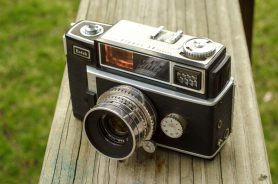
I don’t know for sure, but this might offer a hint. Like you, if wanted to get my hands on one of these for a long time. A number of years ago I did get one, in nice condition, and also its 90mm telephoto lens in a nice leather stringbag case. After checking it out, I immediately loaded it up.
I never did finish shooting that one roll of film in it. It worked ok, but the camera was just not very interesting or pleasant to use compared to just about anything else. Like the suburban environment that so many of us live in, it just lacked personality; it did not have the sense of engagement and mechanical interest that you get from even something like an Argus C3.
I have another nonworking one, and the beginning of a set of disassembly notes…. but those aren’t finished either, as I never sorted out how to completely disassemble it and get it working.
I actually took one of them apart and it’s pretty obvious why these things fail so easily. All the internal metal parts are made of cheap, soft, stamped metal. There’s very few machined parts in there.
The shutter speed selector is a circle with cogs that when you turn the dial, it rests in a cog to set the speed. The cog is soft metal that you can bend by hand.
Also, the lens mounting plate is the same soft metal that in all 3 of the ones I have, is bent. If you have one that works, never take the lens off, as you may never be able to get it back on correctly.
I had a Signet 40 for a while, and its lens performed surprisingly well. I’d expect the same from this Signet 80 if it worked!
Kodak never had a problem making cheap cameras with excellent lenses. I still say that the Signet 35 is one of the most underappreciated 35mm cameras of all time. The Signet 40 is close behind, if not for that ridiculous triple-wind film advance. Even Kodak’s 700 and 800 series Instamatic cameras had great lenses. They just really SUCKED at consistently making cameras that sold well.
My late father was a camera buff and I received his mini trove of old cameras 10 years ago, among them a Kodak Signet 35 and 80. The 35 seemed to work mechanically speaking but the lens was cloudy and the range finder was practically opaque. The Signet 80 worked quite well, in fact it went to Greece with me as a teenager in 1977 and it performed admirably. Later in its life one of the viewfinder lenses became dislocated so focusing was rendered impossible. It was a quirky old thing but took really good pictures while the viewfinder functioned. The film advance lever took several swipe-throughs to get to the next frame. The camera’s chock-a-block design was a bit odd as if done by two of three different committees. Split level houses were all the rage back then and this thing does have that 50s architectural look to it. Unfortunately, they were of such little value I got rid of the lot a few years ago. Too bad. Had I fixed the rangefinder it would have worked just fine, but I was slowly sinking into the digital morass with an ongoing bout of G.A.S.so away they went.
I have three Kodak signet 80 cameras and one is a complete set with the 3 lenses aux finder and the cover for the meter…I also have another one with a very low serial number 0084,The complete set one works but damm no wonder why Kodak decided to go point and shoot,they cut so many corners on what could of been a good camera,Yes lots of soft metal parts etc..The only good thing about this camera is that it looks nice and nothing more…I had four of them but I took one apart(big mistake) so I’m stuck with a carcass too…Gonna keep the complete set and the low serial number one for display and the shutter is very finicky on that one..Oh well no wonder why the Germans and Japanese seized on making way better cameras…Kodak layed too many eggs…
In my opinion, the Signet 80 has two redeeming values. First, the lenses. As is the case with all of Kodak’s Signet cameras, the Signet 80s lenses are excellent. They’re as good in my opinion than most Zeiss or Schneider lenses of the same period. The second is the viewfinder. The Signet 80’s rose colored viewfinder is not only huge, but very easy to use and something I wish they had included on a better camera. You’re right though, the rest of the camera is a disaster.
Since posting this “dead camera” review, I have been able to get ahold of a fully working Signet 80 and have already shot some photos with it and one of these days, I will be sure to update this review with some samples from a working copy!
Hallo Mike.
I got a box (leather) from germany with 5 Schneider Kreuznach lenses ( in seperate contaning “domes” a Instametic reflex spacer and some small things, The box is appently made for the lenses. The lenses are all kreuznach and 200 mm, 85 mm (2X), 135 mm, 35 mm . aT The front is printed Kodak (germany) at the bottom 68187 or O. Do you know anything about this??
My best guess is these are lenses for the Kodak Retina Reflex, probably the S, III, and IV as the original Reflex used a different mount. The later mount is called the DKL mount and was compatible with the Instamatic Reflex. Most of the lenses were made by Schneider Krueznach, as your kit has and they came in those clear plastic bubbles. Sounds like a complete kit. If you can find a working Retina Reflex, they’re great cameras to shoot. If you’re not interested in film, you can adapt DKL mount lenses to most modern digital mirrorless cameras and they produce wonderful results.